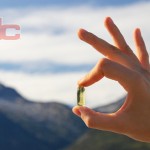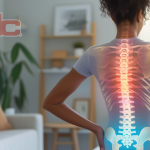
From screen fatigue to age‑related macular degeneration (AMD), patients are more aware than ever of threats to their vision. Nutrients such as lutein and zeaxanthin carry strong clinical support for their role in promoting eye health. For doctors of chiropractic focused on whole‑person wellness, Lutein FloraGLO by Dee Cee Laboratories offers a once‑daily, scientifically validated option to bolster visual resilience.
Why does visual support matter?
AMD is the leading cause of irreversible vision loss in adults over 60, affecting more than 11 million people in the US. It often goes unnoticed until central vision blurs or reading becomes difficult—a point at which the damage is often irreversible.
Meanwhile, prolonged exposure to blue light from digital screens is causing symptoms like strained eyes, headaches and dry vision across all age groups. Dietary intake of protective carotenoids remains low, particularly among patients who consume fewer leafy greens and colorful vegetables.
How lutein and zeaxanthin work
Lutein and zeaxanthin are the only dietary carotenoids deposited in the macula, a central region of the retina responsible for sharp vision. They act as both blue‑light filters and antioxidants, protecting photoreceptor cells. One randomized, placebo‑controlled study in China showed that professional drivers taking 20 mg of lutein daily experienced significant increases in macular pigment optical density (MPOD) and improvements in contrast sensitivity and glare recovery over a year.1
Perhaps the clearest evidence comes from the AREDS2 trial. This large US study demonstrated that subjects supplementing with 10 mg lutein and 2 mg zeaxanthin daily reduced the progression to advanced AMD by around 10% compared to those on beta‑carotene-based formulas.2 A 2022 follow-up confirmed a sustained benefit.3
Beyond AMD, a clinical trial of patients with early, nonadvanced AMD reported that adding carotenoids—including meso‑zeaxanthin—improved contrast sensitivity, photostress recovery, glare resistance and reading speed. In healthy adults with long-term screen exposure, 12 weeks of lutein supplements (6 or 12 mg) improved contrast sensitivity significantly, with stronger effects at the higher dose.4
Lutein intervention has shown benefits for young eyes, too. In a 2025 study, healthy pre-teen and teen participants receiving a daily lutein gummy experienced a 14% increase in MPOD density compared to those taking a placebo.5
How much lutein are patients actually getting?
According to an MDPI review, average lutein intake among US adults is only 2.7 mg for men and 3.1 mg for women—well below the 6–10 mg daily level suggested for optimal eye health.6 Higher daily intake of lutein and zeaxanthin has been associated with long-term reduction in advanced AMD risk in cohort studies.7
What makes Dee Cee Laboratories’ Lutein FloraGLO a smart choice?
Lutein FloraGLO contains 20 mg lutein and 1 mg zeaxanthin in a proprietary FloraGLO® softgel. The once‑daily softgel simplifies dosing, and it is non‑GMO and allergen‑free, delivering nutrients in a ratio that mimics macular tissue. Lutein FloraGLO has been proven to elevate serum lutein and MPOD, even via 5-mg daily doses, within six months.8
Lutein has demonstrated very few side effects and is well-tolerated at up to 20 mg daily for most people, though no universal dosing recommendation exists.9,10
Who can benefit most from Lutein FloraGLO?
Patients most likely to benefit from this supplement include:
- Individuals over 50, especially those with early AMD signs or family history of the condition
- People who spend long hours looking at screens, such as remote workers, gamers or students
- Smokers or former smokers, who face higher oxidative risk
- People who don’t eat many fruits or vegetables
- Anyone noticing glare sensitivity, eyestrain, blurred vision or headaches.
While Lutein FloraGLO can help the above populations, even younger adults may gain benefits such as enhanced contrast, better glare recovery and faster visual processing speed.
Integrate it into your practice
Recommending Lutein FloraGLO to your patients is a way for you to offer them evidence‑based eyesight support. You can introduce it during wellness consultations, offer it in-clinic, or bundle it with other supplements and customized nutritional advice.
Patients appreciate a clear rationale and simple instructions: Lutein/zeaxanthin directly protects vision, and they need to take one softgel daily. Tracking MPOD biofeedback or symptom surveys at six and 12 months reinforces patient compliance by letting them see exactly how much it is helping.
Final thoughts
Vision loss may feel inevitable to patients as they age—but it doesn’t have to be. Carotenoids such as lutein and zeaxanthin are backed by decades of clinical research, including AREDS2 and modern trials. By stocking or recommending Dee Cee Laboratories’ Lutein FloraGLO, you’re offering patients a proactive, credible, convenient way to protect their sight.
References
- Yao Y, et al. Lutein supplementation improves visual performance in Chinese drivers: 1-year randomized, double-blind, placebo-controlled study. Nutrition. 2013 Jul-Aug;29(7-8):958-64. http://pubmed.ncbi.nlm.nih.gov/23360692/. Accessed July 18, 2025.
- Age-Related Eye Disease Study 2 (AREDS2) Research Group; Chew EY, et al. Secondary analyses of the effects of lutein/zeaxanthin on age-related macular degeneration progression: AREDS2 report No. 3. JAMA Ophthalmol. 2014 Feb;132(2):142-9. https://pubmed.ncbi.nlm.nih.gov/24310343/. Accessed July 18, 2025.
- Chew EY, et al. Long-term outcomes of adding lutein/zeaxanthin and ω-3 fatty acids to the AREDS supplements on age-related macular degeneration progression: AREDS2 Report 28. JAMA Ophthalmol. 2022 Jul 1;140(7):692-698. https://pubmed.ncbi.nlm.nih.gov/35653117/. Accessed July 18, 2025.
- Akuffo KO, et al. The impact of supplemental antioxidants on visual function in nonadvanced age-related macular degeneration: A head-to-head randomized clinical trial. Invest Ophthalmol Vis Sci. 2017 Oct 1;58(12):5347-5360. https://pubmed.ncbi.nlm.nih.gov/29053808/. Accessed July 18, 2025.
- Fonseca B. The impact of lutein on macular pigment density in healthy adolescents: A randomized controlled trial. Invest Ophthalmol Vis Sci. 2025;66(8):1013. https://iovs.arvojournals.org/article.aspx?articleid=2806197/. Accessed July 18, 2025.
- Ma L, Lin XM. A 12‑week lutein supplementation improves visual function in Chinese people with long‑term computer display light exposure. Brit J Nutr, 2009. https://pubmed.ncbi.nlm.nih.gov/19586568/. Accessed July 18, 2025.
- Goh KM, et al. Effect of dietary supplementation with lutein, zeaxanthin, and elderberries on dry eye disease (DED) and immunity: A randomized controlled trial. Nutrients. 2024; 16(24):4366. https://www.mdpi.com/2072-6643/16/24/4366/. Accessed July 18, 2025.
- Wu J, et al. Intakes of lutein, zeaxanthin, and other carotenoids and age-related macular degeneration during 2 decades of prospective follow-up. JAMA Ophthalmol. 2015 Dec;133(12):1415-24. https://pubmed.ncbi.nlm.nih.gov/26447482/. Accessed July 18, 2025.
- National Capital Poison Center. Safety and Benefits of Lutein. https://www.poison.org/articles/lutein-safety-and-benefits-172. Accessed July 18, 2025.
- Ranard KM, et al. Dietary guidance for lutein: consideration for intake recommendations is scientifically supported. Eur J Nutr 56 (Suppl 3), 37–42 (2017). https://link.springer.com/article/10.1007/s00394-017-1580-2/. Accessed July 18, 2025.







